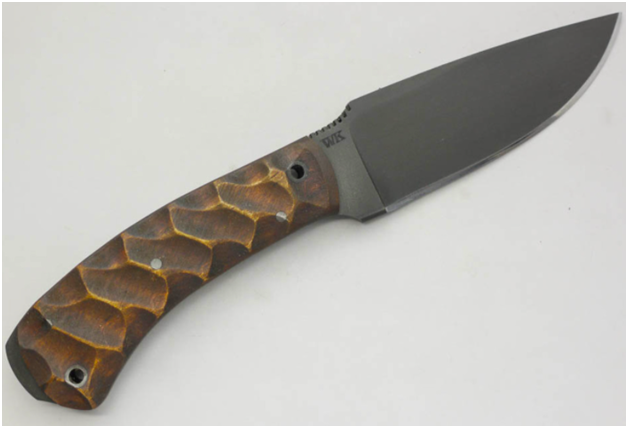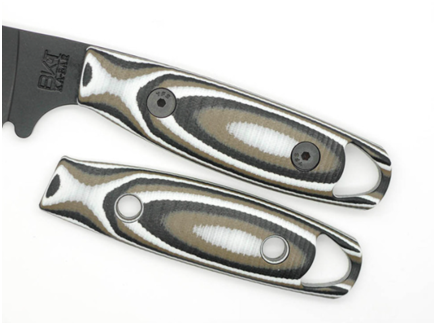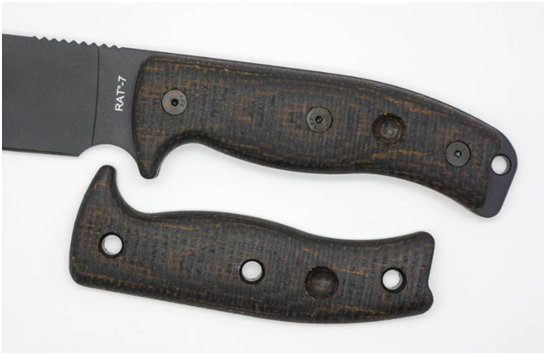Most Common Materials for Knife Handles
Oct 25 2021 - 10:18

When you are shopping for a new knife, it is common for you to discover plenty of stellar options and primarily focus on the blade. Is it a drop point or clip point? Is it a folding, bushcraft, camp, hunting, or fishing knife? Is it carbon steel, tool steel, or stainless steel?
In summation, you know that there is a lot you need to take into account when choosing the right blade (and rightfully so). While the blade is exceptionally important to carefully consider, the handle is another component that warrants your close attention as well.
In order to have the best grip on your knife and have a nearly seamless experience with every use, then you should opt for only the best handles that are made with the highest quality materials. Let’s have a look at the most common materials for knife handles so you can find the right one for your favorite blade, whether it’s brand new or requires a handle upgrade.
Natural Materials
There isn’t anything much better than natural in most cases in life and this is true for knife handles . That is why there are several outstanding natural materials for handles and why we’ve chosen to lump them all into their own category together.
Wood
One of the most popular of all the natural materials for handles is wood. When made correctly, it can make your handle exceptionally attractive and durable. Wood adds a unique aesthetic to anything it is used in and this is especially true for knives and their handles.
There are other advantages of wood as your handle’s chosen material, such as a lowered cost, as it is one of the least expensive options. It also comes in a wide variety of tree species so you can choose the most advantageous for you, your particular usage, and even your preferred style.
Having the right species of wood in your wooden handle is vital as well. For example, if you intend on being in wet locations, you should opt for hardwood, as it is injected with plastic/resin for increased stability without sacrificing the appearance.
However, those are two of wood’s downfalls: it can be too porous in certain conditions and scenarios, but also a bit unstable.
Bone, Antler, Horn, and Tusk
Wood is one material that has been used since the dawn of man and his handheld tools, but as has bone. Bone is one of the most classic materials for handles and is still quite often used today. They are beloved by knife collectors and are currently the most often used in pocket knives.
Bone is loved by so many because of its traditionality and stunning aesthetics. Alongside bone, there is also antler, horn, and tusk in knife handles from animals such as deer, elk, sheep, cow, and even elephants (ivory specifically).
While all of these have aesthetic appeal and are quite strong, they are also slippery and porous. They’re highly capable of cracking as well.
Fiberglass Reinforced Nylon (FRN)

Fiberglass Reinforced Nylon, or FRN (and sometimes referred to as GFN), is a high-strength plastic that typically has nylon fibers within it assorted in such a way that provides the user with unparalleled strength.
Due to its injection molding, it can be one of the lesser expensive options available. It is extremely strong and lightweight. It is really no surprise as to why it is one of the most popular options for knife handle materials!
However, it has been said to be inferior in grip and has a cheap plastic feel, which some knife enthusiasts find unappealing.
G-10

G-10 is a woven fiberglass that has first been soaked in epoxy resin, compressed, then baked. What is created from this meticulous process is G-10, a particular grade of Garolite. This material makes for an exceptional handle material because it is lightweight, sturdy, hard, and strong.
This non-porous option is ideal for many knife wielders, no matter if they are in wet or in dry conditions, but especially for those looking for a dependable tactical knife. You will notice that many G-10 handles have a pattern, such as checkering, on them to offer extra grip.
While the G-10 is highly recommended and popular, it has a couple of downfalls to be aware of. It is brittle and lacks any sort of elegant aesthetic.
Micarta

Micarta is extremely similar to the G-10, as it is made of thin layers of cloth that are soaked in Phenol, a type of resin. What results is Micarta, one of the most dependable and strongest knife handle materials available.
Micarta, like the G-10, is extremely lightweight, sturdy, and tough. Because it is a naturally slippery material, a lot of effort and work is required to make it into a handle that can be held and gripped easily. This is why this type of material is on the pricier end. Aside from its larger price tag, it also falls short in resiliency.
Aluminum
The last but certainly not least material for knife handles on our list is aluminum. This well-known low-density metal is a superb material to use in a knife handle (along with a host of other uses!).
In a handle, it creates a hefty feel without being uncomfortably heavyweight. It is exceptionally strong and lightweight while also being resilient to corrosion. With proper texturizing on it, it can even make for a dependable and easy-to-grip handle.
However, no knife handle is without its caveat or two. Having an aluminum handle can make your hand much colder than other types, as aluminum conducts heat very well. On top of that, it can be slippery if it lacks a property texturized handle (as mentioned above). Plus, it is susceptible to damage, like little marks, scratches, and dings.
These are just some of the most common and popular materials used in knife handles on the market today. In order to find the right handle for you, be sure to check out our custom-made knife handle category on our site. Be sure to give us a call at (866) 336-2834 with any questions you may have. We can’t wait to find the right handle-- and overall knife-- for you.